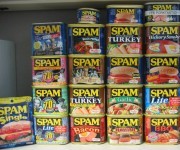Royce’s SPAM collection.
Food Studies features the voices of 11 volunteer student bloggers from a variety of different food- and agriculture-related programs at universities around the world. You can explore the full series here.
In the 10th grade, I took a speech class. We were asked to write speeches of the following varieties: persuasive, informative, ceremonial, and instructional. We were free to choose the topics.
When it came time to write my “informative” speech, I chose to write it on the history of Spam. This was the 1990s, before “spam” referred to the unwanted messages in your email inbox. Instead, I focused on the potted meat product that had somehow achieved this weird place in pop culture, borrowing its humor from jokes about mystery meat and saying something, I suppose, about the homogenization of lowbrow American cuisine (though I doubt that I or any of my friends thought about it in those terms then). I remember the speech ended up containing some information about food in the military and about Spam’s popularity in Hawaii. I know I also threw in an anecdote from my father, who recalled Spam being a major treat when he was a child in his native Russia, in the years after World War II.
Now, looking back, I must have just thought it was funny. Yet maybe there was something more to it, because today I’m a graduate student preparing a doctoral dissertation on the history of canned food in America. Spam, in some ways, is the quintessential canned food, and its pop cultural status actually captures many of the interesting historical themes I am examining in my dissertation.
So maybe my Spam speech wasn’t a total joke after all. Or, at least, whatever I’m studying, Spam seems destined to be the punch line.
When I was accepted to graduate school in a History of Science department, I knew I was interested in the environment, and in the way that science and scientific expertise entered broader culture. Then, during my recruitment weekend, I ended up having a brief conversation with an older graduate student who said he studied the history of food. I hadn’t even known that there was such a sub-discipline, or that it was something I could seriously study. But there it was.
And, although it took me a few years to return to this possibility in earnest, it was always there, just beneath my consciousness, tempting me with its possibility of bringing together my academic and personal interests.
Because, the thing is, I love food. I love eating it, growing it, cooking it, thinking about it, writing about it, sharing it with friends, and pretty much anything else to do with it. And now I have the opportunity to make it my vocation, and not just my avocation.
This fall, I’ll not only be writing about my dissertation work, but also about some of the other ways that I get to connect with food these days. Although I read, think, and write about canned food, I cook often, with local foods as much as possible (and I even got to cater a wedding earlier this year!). I work in various capacities — as a kids’ garden intern, social media guru, and fundraiser — with Community GroundWorks, a local nonprofit that connects people to nature and food. I organize local food tours of my city: Madison, Wis. I work as a food intern for the GreenHouse, an environmental living community on campus, through which I organize a series of Global Food for Thought Meals. This semester, I am teaching a small seminar on food ethics to a group of GreenHouse residents. In addition to my updates here, I’ll be writing about all this, and more, daily, at my personal blog, Dining and Opining. So it’s okay: I can guarantee you I’ll be serving more than Spam this fall!



